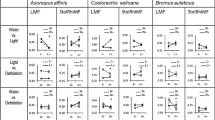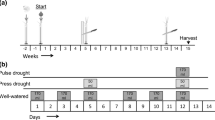Abstract
We determined the effects of defoliation by a graminivorous grasshopper on the foliage quality of the C3 plant, western wheatgrass (Pascopyrum smithii [Rydb] A. Love). Additionally, we determined the effects of this defoliation upon the subsequent feeding of the graminivorous grasshopper Phoetaliotes nebrascensis Thomas (Orthoptera: Acrididae). In field and greenhouse studies, graminivorous grasshopper herbivory altered the quality of remaining western wheatgrass foliage. In the greenhouse, severe (50% foliage removal) grasshopper grazing (638 grasshoppers/m2 for 72h) resulted in decreased foliar nitrogen (−12%), carbohydrate (−11%) and water (−2.5%) concentrations, and increased phenolic concentrations (+43%). These changes were associated with decreased adult female grasshopper mass gain, consumption rate, approximate digestibility, and food conversion efficiencies. In the field, moderate (14% foliage removal) grasshopper grazing (20 grasshoppers/m2 for 20 days) led to a 10% reduction in foliar nitrogen concentrations. Foliage quality changes in the field were not associated with any reductions in grasshopper mass gain, consumption rates, food digestibility, or conversion efficiencies. The results presented here are consistent with the hypothesis that defoliation leads to a reallocation of carbon and nitrogen compounds within the plant such that foliage quality for P. nebrascensis is reduced.
Similar content being viewed by others
References
Asquith TN, Butler LG (1985) Use of dye labeled protein as spectrophotometric assay for protein precipitants such as tannin. J Chem Ecol 11: 1535–1544
Association of Official Analytical Chemists (1984) Official methods of analysis, 14th edn. Association of Official Chemistry, Arlington
Barnes OL (1955) Effect of food plants on the lesser migratory grasshopper. J Ecol Entomol 48: 119–124
Bergelson J, Fowler S, Hartley S (1986) The effects of foliage damage on casebearing moth larvae, Coleophora serratella, feeding on birch. Ecol Entomol 11: 241–250
Bernays EA, Barbehenn R (1987) Nutritional ecology of grass foliage-chewing insects. In: Slansky F, Rodriguez JG (eds) Nutritional ecology of insects, mites, and spiders. Wiley, New York, pp 147–175
Brizucla MA, Detling JK, Cid MS (1986) Silicon concentration of grasses growing in sites with different grazing histories. Ecology 67: 1098–1101
Bryant JP, Chapin Klein DR (1983) Carbon/nutrient balance of boreal plants in relation to vertebrate herbivory. Oikos 40 357–368
Capinera JL, Roltsch WJ (1980) Response of wheat seedlings to actual and simulated migratory grasshopper defoliation. J Econ Entomol 73: 258–261
Capinera JL, Sechrist TS (1982) Grasshopper (Acrididae) of Colorado: identification, biology and management (Colorado State Univ Exp Sta Bull 584S). Colorado State University, Ft Collins, CO
Carroll CR, Hoffman CA (1980) Chemical feeding deterrent mobilized in response to insect herbivory and counteradaptation by Epilachna tredecimnotata. Science 209: 414–416
Detling JK, Dyer MI (1981) Evidence for potential plant growth regulators in grasshoppers. Ecology 62: 485–488
Detling JK, Dyer MI, Winn DT (1979) Effects of simulated grass-hopper grazing on CO2 exchange rates of western wheatgrass leaves. J Econ Entomol 72: 403–406
Dyer MI, Bokhari UG (1976) Plant-animal interactions: studies of the effects of grasshopper grazing on blue gramma grass. Ecology 57: 762–772
Edwards PJ, Wratten SD (1985) Induced plant defenses against insect grazing: fact or artefact? Oikos 44: 70–74
Edwards PJ, Wratten SD, Cox H (1985) Wound-induced changes in the acceptability of tomato to larvae of Spodoptera littoralis: a laboratory bioassay. Ecol Entomol 10: 155–158
Edwards PJ, Wratten SD, Greenwood S (1986) Palatability of British trees to insects: constitutive and induced defenses. Oecologia 69: 316–319
Forno IW, Semple JL (1987) Response of Salvinia molesta to insect damage: changes in nitrogen, phosphorous and potassium content. Oecologia 73: 71–74
Fowler SV, Lawton JH (1985) Rapidly induced defenses and talking trees: the devil's advocate position. Am Nat 126: 181–195
Gwynne DT (1983) Male nutritional investment and the evolution of sexual differences in Tettigoniidae and other Orthoptera. In: Gwynne DT, Morris GK (eds) Orthopteran mating systems. Sexual competition in a diverse group of insects. Westview, Boulder, pp 335–366
Gwynne DT (1988) Courtship feeding and the fitness of female katydids (Orthoptera: Tettigoniidae). Evolution 42: 545–555
Hartley SE, Lawton JH (1987) Effects of different types of damage on the chemistry of birch foliage, and the responses of birch feeding insects. Oecologia 74: 432–437
Hartley, SE, Lawton JH (1991) Biochemical aspects and significance of the rapidly induced accumulation of phenolics in birch foliage. In: Tallamy DW, Raupp MJ (eds) Phytochemical induction by herbivores. Wiley, New York, pp 105–132
Haukioja E (1982) Inducible defenses of white birch to a geometrid defoliator, Epirrita autumnata. In: Visser JH, Minks AK (eds) Proceedings of the 5th international symposium on insect-plant relationships. Pudoc, Wageningen, pp 199–203
Hewitt GB, Onsager (1983) Control of grasshoppers on rangeland in the United States — a perspective. J Range Manage 36: 202–207
Karban R (1993) Costs and benefits of induced resistance and plant density for a native shrub, Gossypium thurberi. Ecology 74: 9–19
Karban R, Myers JH (1989) Induced plant responses to herbivory. Annu Rev Ecol Syst 20: 331–348
Kogan M, Parra JRP (1981) Techniques and applications of measurements of consumption and utilization of food by phytophagous insects. In: Bhaskaran G, Friedman S, Rodriguez JG (eds) Current topics in insect endocrinology and nutrition. Plenum, New York, pp 337–352
McNaughton SJ, Tarrants JL (1983) Grass leaf silicification: Natural selection for an inducible defense against herbivores. Proc Natl Acad Sci 80: 790–791
McNaughton SJ, Tarrants JL, McNaughton MM, Davis RH (1985) Silica as a defense against herbivory and a growth promotor in African grasses. Ecology 66: 528–535
Mole S, Joern A (1993) Foliar phenolics of Nebraska sandhills prairie graminoids: between-years, seasonal, and interspecific variation. J Chem Ecol 19: 1861–1874
Myers JH (1988) The induced defense hypothesis: does it apply to the population dynamics of insects? In: Spencer KC (ed) Chemical mediation of coevolution. Academic Press, San Diego, pp 345–366
Neuvonen S, Haukioja E, Molarius A (1987) Delayed inducible resistance against a leaf-chewing insect in four tree species. Oecologia 74: 363–369
Niemela P, Aro EM, Haukioja E (1979) Birch leaves as a resource for herbivores: damage-induced increase in leaf phenols with trypsin-inhibiting effects. Rep Kevo Subarct Res Stat 15: 37–40
Oksanen L, Oksanen T, Lukkari A, Siren S (1987) The role of phenol-base inducible defense in the interaction between tundra populations of the vole Clethrionomys rufocanus and the dwarf shrub Vaccinium myrtillus. Oikos 50: 371–380
Onsager JA (1983) Relationships between survival rate, density, population trends, and forage destruction by instars of grass-hoppers (Orthoptera: Acrididae). Environ Entomol 12: 1099–1102
Painter EL, Delting JK (1981) Effects of defoliation on net photosynthesis and regrowth of western wheatgrass. J Range Manage 34: 68–71
Pfadt RE (1982) Density and diversity of grasshoppers (Orthoptera: Acrididae) in an outbreak on Arizona rangeland. Environ Entomol 11: 690–694
Raubenheimer D (1992) Tannic acid, protein, and digestible carbohydrate: dietary imbalance and nutritional compensation in locusts. Encology 3: 1012–1027
Rhoades DF (1985) Offensive-defensive interactions between herbivores and plants: their relevance in herbivore population dynamics and ecological theory. Am Nat 125: 205–238
Ross CW, Detling JK (1983) Investigations of trypsin inhibitors in leaves of four north American prairie grasses. J Chem Ecol 9: 247–257
Ryan CA (1981) Proteinase inhibitors. In: Stumpf PK, Conn EE (eds) The biochemistry of plants, vol 6. Academic Press, New York, pp 351–370
Schultz JC, Baldwin IT (1982) Oak leaf quality declines in response to defoliation by gypsy moth larvae. Science 217: 149–151
Slansky F, Rodriguez JG (1987) Nutritional ecology of insects, mites, spiders and related invertebrates: an overview. In: Slansky F Rodriguez JG (eds) Nutritional ecology of insects, mites, and spiders. Wiley, New York, pp 1–69
Smith D (1981) Removing and analyzing total nonstructural carbohydrates from plant tissue Univ Wisconsin, College of AgricLife Sci Res Bull R2107). University of Wisconsin, Madison, WI
SPSS Inc. (1986) SPSSx user's guide, 2nd edn McGraw-Hill, New York
Tallamy DW, Raupp MJ (1991) Phytochemical induction by herbivores. Wiley, New York
Trlica MJ, Cook CW (1971) Defoliation effects on carbohydrate reserves of desert species. J Range Manage 24: 418–425
Tuomi J, Niemela P, Haukioja E, Siren S, Neuvonen S (1984) Nutrient stress: an explanation for plant anti-herbivore responses to defoliation. Oecologia 61: 208–210
Uvarov B (1966) Grasshoppers and locusts. A Handbook of general acridology. Anatomy, physiology, development, phase polymorphism, introduction to taxonomy, vol 1. Cambridge University Press, London
Uvarov B (1977) Grasshoppers and locusts. A Handbook of general acridology. Behaviour, ecology, biogeography, population dynamics, vol 2. Centre for Overseas Pest Research, London
Wagner MR, Evans PD (1985) Defoliation increases nutritional quality and allelochemics of pine seedlings. Oecologia 67: 235–237
Waldbauer GP (1968) The consumption and utilization of food by insects. Adv Insect Physiol 5: 229–288
Walmsley MR, Capinera JL, Detling JK, Dyer ML (1987) Growth of blue gramma and western wheatgrass following grasshopper defoliation and mechanical clipping. J Kansas Entomol Soc 60: 51–57
Wratten SD, Edwards PJ, Dunn J (1984) Wound-induced changes in the palatability of Betula pubescens and B. pendula. Oecologia 61: 372–375
Zar JH (1974) Biostatistical analysis. Prentice-Hall, Englewood Cliffs
Author information
Authors and Affiliations
Rights and permissions
About this article
Cite this article
Redak, R.A., Capinera, J.L. Changes in western wheatgrass foliage quality following defoliation: consequences for a graminivorous grasshopper. Oecologia 100, 80–88 (1994). https://doi.org/10.1007/BF00317133
Received:
Accepted:
Issue Date:
DOI: https://doi.org/10.1007/BF00317133




